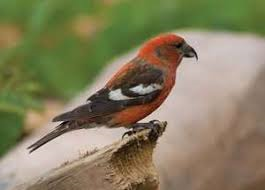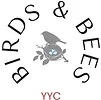ODD BILL SHAPE
In our previous blog post, “The Finches of Winter” we mentioned Crossbills. We thought we would share a little more on these interesting birds. Crossbills feed on pine and spruce cones and its odd bill shape helps it get into tightly closed cones. A bird’s biting muscles are stronger than the muscles used to open the bill. The Crossbill places the tip of its slightly open bill under a cone scale and bites down. The crossed tips of the bill push the scale up, exposing the seed inside which can then be removed at the end of a long tongue. The crossed tips and strong biting muscles are vital for exerting enough pressure to do the job.

Young crossbills hatch with straight bills, with the crossing only taking place after they reach three weeks or so. By this time they will have left the nest to roam the countryside with their parents in search of food.
Crossbills have a fast and undulating flight, often at treetop level. They generally only come to the ground for water. They will sidle along thin branches in a parrot-like fashion, sometimes using the bill for support.
RED CROSSBILL
The Red crossbill shows a great deal of variation in bill shape and voice, and it may in fact be composed of several different species. Eight different flight call types have been described north of Mexico, and birds of each type have slightly differently shaped bills and prefer to feed on different tree species with differently sized cones. Because this species can breed throughout most of the year, its molts and plumages vary more than those of other North American passerines. Juveniles hatched during summer molt only between late summer and late autumn when adults molt. Many, but not all, juveniles hatched earlier, from late winter and early spring, begin to molt 100-110 days after hatching and then again during the main molt period in the summer. The Red crossbill is so dependent upon conifer seeds it even feeds them to its young. Consequently, it can breed any time it finds a sufficiently large cone crop, even in the depths of winter.
WHITEWINGED CROSSBILL
Individual White-winged crossbills can eat up to 3,000 conifer seeds each day. White-winged crossbills with lower mandibles crossing to the right are approximately three times more common than those with lower mandibles crossing to the left. Breeding is opportunistic and can occur throughout the year whenever food is sufficient for the female to form eggs and raise young. White-winged Crossbills molt their feathers once each year, usually in the autumn. The red feathers of the male have unpigmented barbules on the surface that mask the red and make the bird appear pink at first in the fall. As these barbules wear off, the bright red shows through, making the spring and summer male brilliantly coloured.
If you enjoyed this post, we encourage you to signup for our newsletter:
Sign up for our monthly newsletter that keeps you up to date on our in store specials, monthly savings and has great articles about local birds, It also lets you know what upcoming seminars and workshops are happening in our Classroom/Gallery.
By submitting this form, you are consenting to receive marketing emails from: . You can revoke your consent to receive emails at any time by using the SafeUnsubscribe® link, found at the bottom of every email. Emails are serviced by Constant Contact
